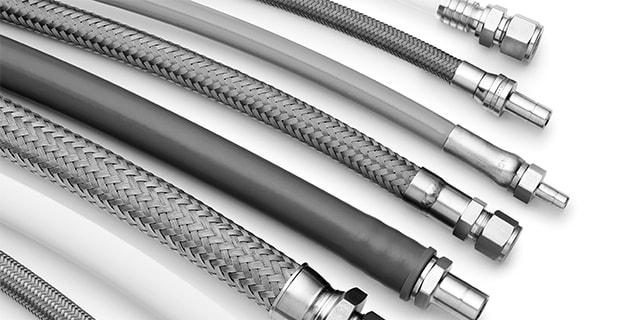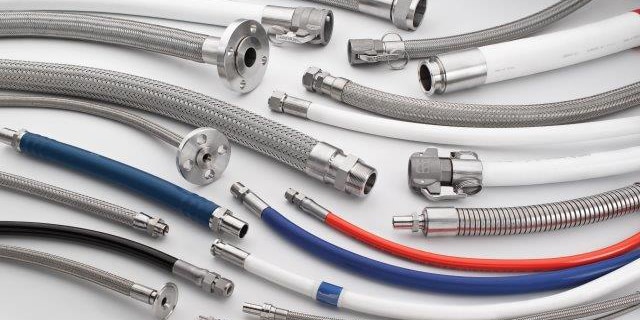
Industrial hoses are incredibly versatile and are used in a variety of industries and applications. They come in a wide range of sizes, shapes, and materials, each with their own set of advantages and uses. In this blog post, we will discuss the different types of industrial hoses, their uses, and their advantages. We will also provide tips on choosing the right type of hose for your application. So, if you’re looking for industrial hoses, this blog post is for you!
Standard Hoses
Strong and durable industrial hoses are an essential part of any industry. Standard hoses are used to convey air, water, oil, gas, and other fluids, and can also be used for other purposes such as transferring steam, chemicals, and materials between two points. Standard hoses are generally made from rubber, plastic, or fabric, and they come in a variety of sizes and lengths.
Standard hoses are designed to withstand temperature variations, high pressure, corrosive materials, and other conditions. They are designed to handle a wide range of applications, from low-pressure water to high-pressure gas transfer. The types of hoses available include air hoses, water hoses, chemical hoses, hydraulic hoses, gas hoses and many more.
These strong and durable hoses are perfect for use in a variety of industries, from automotive to construction. They are easy to install, long lasting, and can handle extreme temperatures and pressures. By investing in quality standard hoses, you can ensure your operations run smoothly and efficiently.
Heavy Duty Hoses
When the job calls for more than a standard hose, then heavy duty hoses are the answer. These strong and durable industrial hoses are designed for a wide range of applications and are made from the highest quality materials. They can handle high pressure, abrasive materials, and extreme temperatures.
Heavy duty hoses are used in a variety of industrial applications, such as: oil and gas production, food and beverage processing, marine environments, and construction sites. They’re available in various sizes and lengths and feature special reinforcement that provides extra strength to handle the toughest jobs.
These hoses are ideal for conveying liquids, steam, solids, gases, and more, as well as for cleaning and other operations. They’re also highly resistant to corrosion, chemicals, ozone, abrasion, and weathering. When used properly, they can withstand temperatures up to 250°F (120°C).
Layflat Hoses
Layflat hoses are strong and durable industrial hoses designed to provide excellent abrasion and kink resistance. They have a wide range of applications including, water transfer, firefighting, and irrigation. Layflat hoses are constructed with a single ply of synthetic material reinforced with multiple layers of PVC or rubber. They are lightweight, flexible, and available in a variety of colours and sizes. Layflat hoses are often used as a safe and cost-effective alternative to steel pipes. They can be used in various industries such as oil and gas, chemical, construction and more. Layflat hoses are also highly resistant to UV radiation and abrasion, making them an ideal choice for extended outdoor use.
Suction and Discharge Hoses
Suction and discharge hoses are an essential part of any industrial operation. These hoses provide a means for transferring liquids, gases, and other materials from one location to another, enabling you to move materials more safely and quickly than ever before.
Suction and discharge hoses are typically made from rubber or PVC and are available in a variety of diameters and lengths to meet the needs of your application. Depending on the application, you may also find suction and discharge hoses made of other materials such as polyurethane, vinyl, or even metal.
There are several types of suction and discharge hoses designed to meet different applications. Some common types of suction and discharge hoses include:
- Standard suction and discharge hoses – These hoses are designed to transfer light to medium fluids over short distances. They are usually constructed with rigid wire helixes, allowing them to hold their shape despite pressure.
- Heavy-duty suction and discharge hoses – As the name implies, these hoses are designed to handle heavy-duty applications. They are typically constructed with metal helixes and are highly resistant to abrasion, corrosion, heat, and cold.
- Lay flat suction and discharge hoses – These hoses have a unique construction that allows them to be stored flat, saving space when not in use. They are great for applications where manoeuvrability is key, as they can be moved around easily.
- Thermoplastic suction and discharge hoses – These hoses are made with thermoplastic material, which makes them highly resistant to wear and tear. They are ideal for transferring abrasive fluids or materials that may contain solvents or chemicals.
Thermoplastic Hoses
Thermoplastic hoses are designed for a wide range of industrial and commercial applications. These flexible, lightweight hoses are extremely durable and offer superior abrasion and chemical resistance. They can withstand temperatures ranging from -4°F to +302°F and are ideal for applications involving hydraulic oils, solvents, fuels, refrigerants, and many other fluids.
Due to their excellent durability and flexibility, thermoplastic hoses are becoming increasingly popular in many industries. They can be used to transport various chemicals, such as glycols, organic acids, and hydrocarbons, as well as corrosive chemicals, such as strong acids, chlorinated solvents, and amines. Additionally, they can be used to transport water, air, and steam.
Thermoplastic hoses are available in a wide variety of sizes and configurations. Different types of fittings and connections can be used to create custom hose solutions that are tailored to meet the specific requirements of your application. For example, some thermoplastic hoses come with bend restrictors or swivel fittings to make them more user friendly. Additionally, these hoses can be used with a variety of couplings and clamps for easy installation.
In addition to being highly durable and flexible, thermoplastic hoses are also lightweight and easy to handle. Their low weight makes them ideal for applications where portability is an issue. Additionally, they require little maintenance and can often outlast traditional rubber or metal hoses.
Overall, thermoplastic hoses are a great choice for a wide range of industrial applications. They offer superior durability, flexibility, and chemical resistance while being lightweight and easy to use. If you’re looking for an effective and economical solution to your industrial needs, thermoplastic hoses may be the perfect solution.
Rubber Hoses
Rubber hoses are one of the most versatile types of industrial hoses. They are made from natural or synthetic rubber and can be used in a variety of applications. Rubber hoses are suitable for a wide range of temperatures and pressures, making them an ideal choice for high-pressure or hot applications. They are also highly flexible, allowing for easy installation and providing superior vibration and shock absorption.
Rubber hoses are commonly used for automotive cooling systems, steam transfer, and water discharge. They can also be used for air conditioning systems, as fuel lines, for exhaust gas transfer, and as hydraulic lines. Additionally, rubber hoses are a popular choice for industrial process piping due to their durability and flexibility. They are available in a range of sizes, colours, and materials, so they can be easily customized to fit any application.
When selecting a rubber hose, it is important to consider the pressure and temperature rating of the hose, as well as its compatibility with the material being transferred. The right hose should also be resistant to ozone, UV rays, heat, and wear. Finally, it is important to select a hose that is resistant to chemicals, oils, and fuels.
Composite Hoses
Composite hoses are made from different materials, such as polypropylene, nylon and polyurethane. They are designed for a variety of industrial applications, such as transferring liquids and gases, carrying hazardous materials and suctioning water and chemicals.
Composite hoses are designed to be lightweight and flexible, yet also very durable. They can handle extreme temperatures and pressures, making them an excellent choice for many industrial settings. The composite construction also makes them resistant to corrosion and abrasion, as well as to ozone and UV damage.
When choosing a composite hose, it is important to consider the type of media being transferred, the pressure and temperature requirements, as well as the desired bend radius. This is important because different composite hoses will have different levels of resistance to the media being transferred.
For safety reasons, it is also important to use the right fittings and clamps with composite hoses. Clamps should be made of stainless steel or another material that is suitable for the application. Fittings should be compatible with the type of composite hose being used and should have adequate leak protection.









